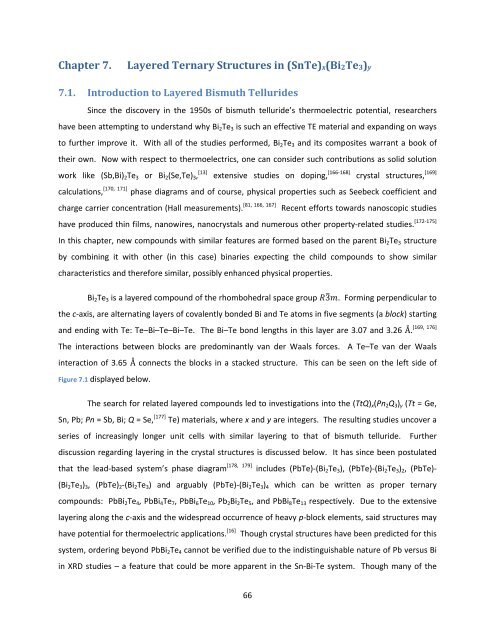Exploration and Optimization of Tellurium‐Based Thermoelectrics
Exploration and Optimization of Tellurium‐Based Thermoelectrics
Exploration and Optimization of Tellurium‐Based Thermoelectrics
You also want an ePaper? Increase the reach of your titles
YUMPU automatically turns print PDFs into web optimized ePapers that Google loves.
Chapter 7. Layered Ternary Structures in (SnTe)x(Bi2Te3)y<br />
7.1. Introduction to Layered Bismuth Tellurides<br />
Since the discovery in the 1950s <strong>of</strong> bismuth telluride’s thermoelectric potential, researchers<br />
have been attempting to underst<strong>and</strong> why Bi2Te3 is such an effective TE material <strong>and</strong> exp<strong>and</strong>ing on ways<br />
to further improve it. With all <strong>of</strong> the studies performed, Bi2Te3 <strong>and</strong> its composites warrant a book <strong>of</strong><br />
their own. Now with respect to thermoelectrics, one can consider such contributions as solid solution<br />
work like (Sb,Bi)2Te3 or Bi2(Se,Te)3, [13] extensive studies on doping, [166‐168] crystal structures, [169]<br />
calculations, [170, 171] phase diagrams <strong>and</strong> <strong>of</strong> course, physical properties such as Seebeck coefficient <strong>and</strong><br />
charge carrier concentration (Hall measurements). [81, 166, 167] Recent efforts towards nanoscopic studies<br />
have produced thin films, nanowires, nanocrystals <strong>and</strong> numerous other property‐related studies. [172‐175]<br />
In this chapter, new compounds with similar features are formed based on the parent Bi2Te3 structure<br />
by combining it with other (in this case) binaries expecting the child compounds to show similar<br />
characteristics <strong>and</strong> therefore similar, possibly enhanced physical properties.<br />
Bi2Te3 is a layered compound <strong>of</strong> the rhombohedral space group 3. Forming perpendicular to<br />
the c‐axis, are alternating layers <strong>of</strong> covalently bonded Bi <strong>and</strong> Te atoms in five segments (a block) starting<br />
[169, 176]<br />
<strong>and</strong> ending with Te: Te–Bi–Te–Bi–Te. The Bi–Te bond lengths in this layer are 3.07 <strong>and</strong> 3.26 Å.<br />
The interactions between blocks are predominantly van der Waals forces. A Te–Te van der Waals<br />
interaction <strong>of</strong> 3.65 Å connects the blocks in a stacked structure. This can be seen on the left side <strong>of</strong><br />
Figure 7.1 displayed below.<br />
The search for related layered compounds led to investigations into the (TtQ)x(Pn2Q3)y (Tt = Ge,<br />
Sn, Pb; Pn = Sb, Bi; Q = Se, [177] Te) materials, where x <strong>and</strong> y are integers. The resulting studies uncover a<br />
series <strong>of</strong> increasingly longer unit cells with similar layering to that <strong>of</strong> bismuth telluride. Further<br />
discussion regarding layering in the crystal structures is discussed below. It has since been postulated<br />
that the lead‐based system’s phase diagram [178, 179] includes (PbTe)‐(Bi2Te3), (PbTe)‐(Bi2Te3)2, (PbTe)‐<br />
(Bi2Te3)3, (PbTe)2‐(Bi2Te3) <strong>and</strong> arguably (PbTe)‐(Bi2Te3)4 which can be written as proper ternary<br />
compounds: PbBi2Te4, PbBi4Te7, PbBi6Te10, Pb2Bi2Te5, <strong>and</strong> PbBi8Te13 respectively. Due to the extensive<br />
layering along the c‐axis <strong>and</strong> the widespread occurrence <strong>of</strong> heavy p‐block elements, said structures may<br />
have potential for thermoelectric applications. [16] Though crystal structures have been predicted for this<br />
system, ordering beyond PbBi2Te4 cannot be verified due to the indistinguishable nature <strong>of</strong> Pb versus Bi<br />
in XRD studies – a feature that could be more apparent in the Sn‐Bi‐Te system. Though many <strong>of</strong> the<br />
66
















